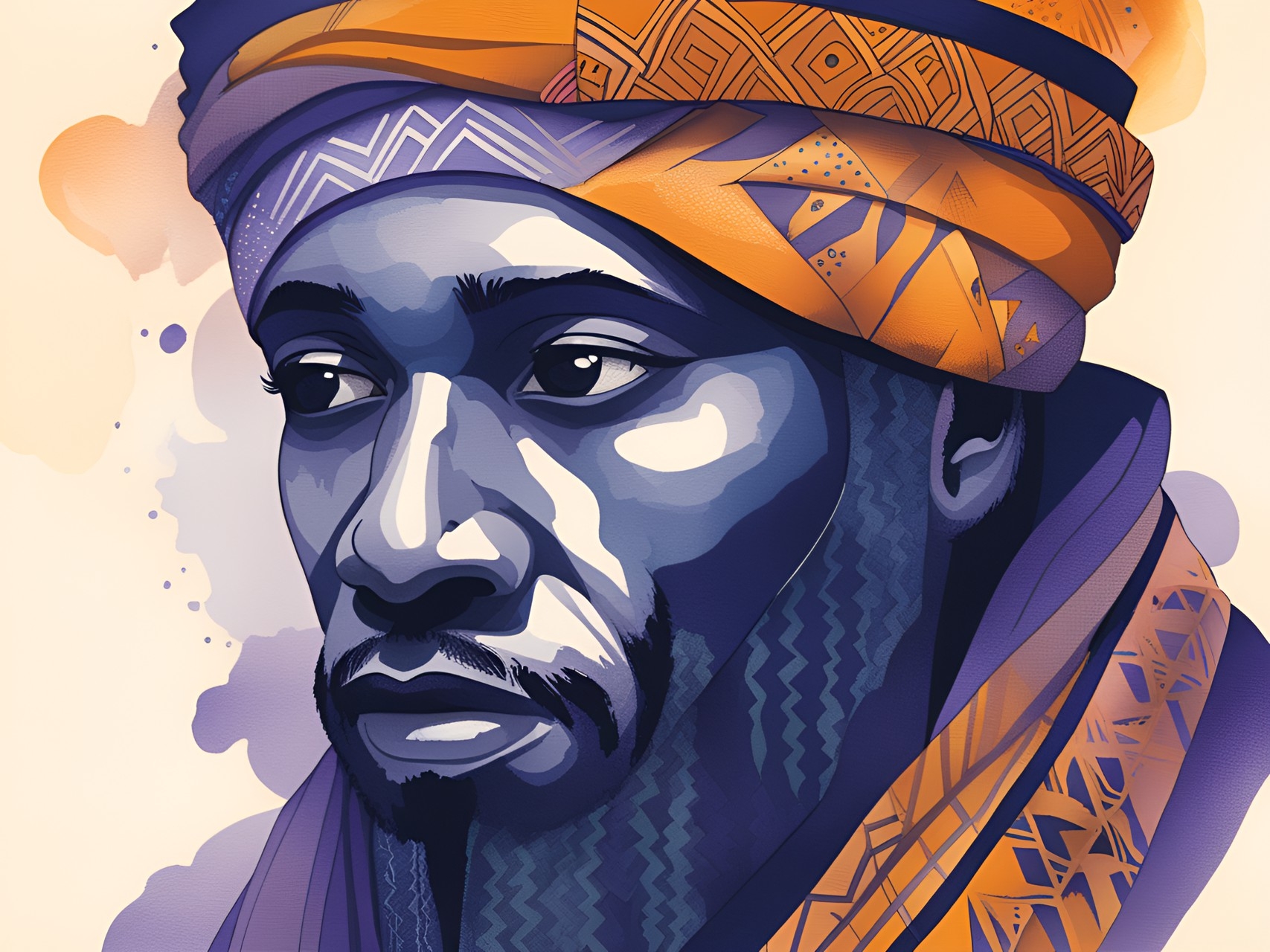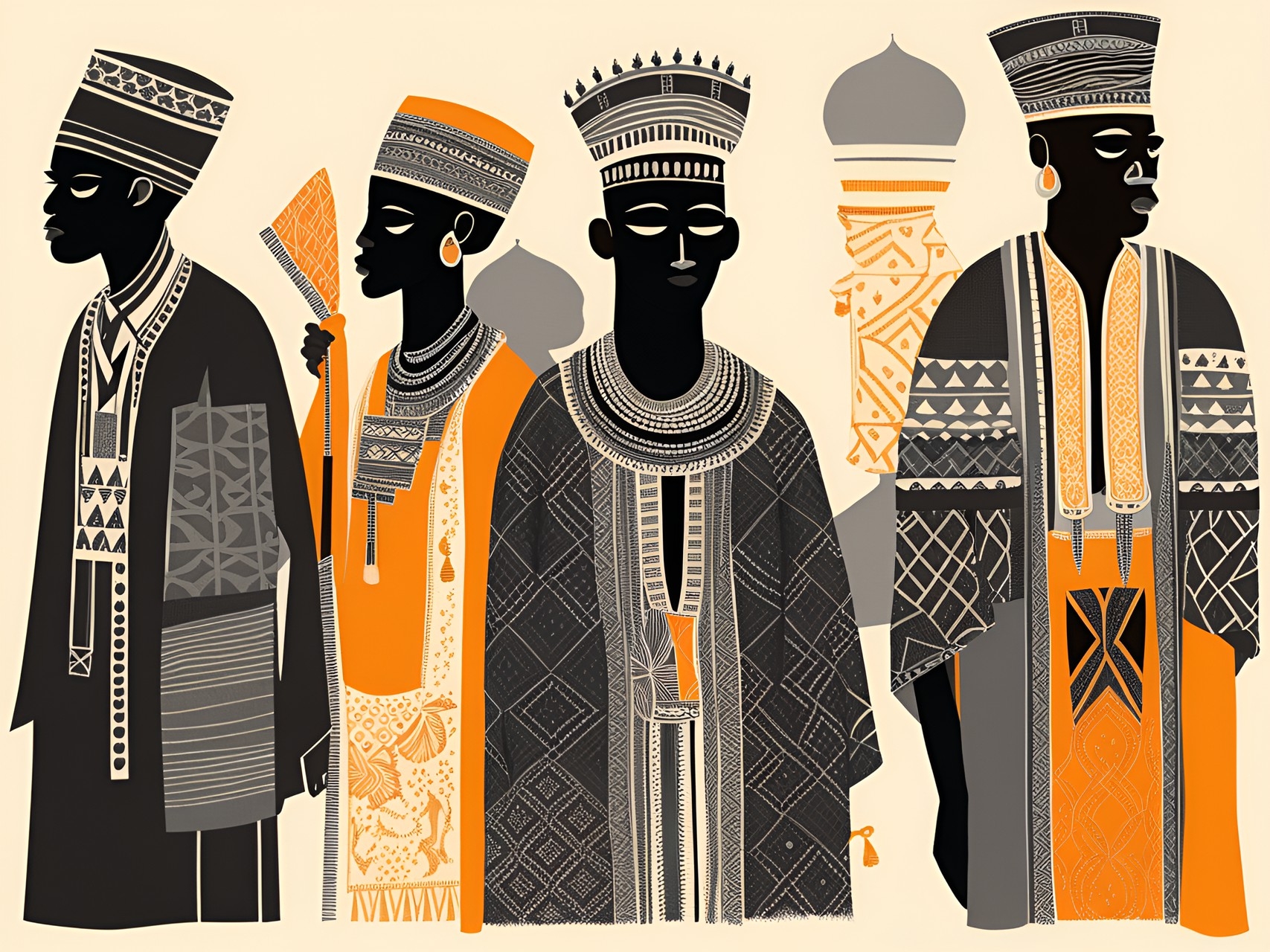Kanuri
The Kanuri descend from the ruling lines of the Kanem and Bornu Empires of Kasar Wuta, living in Kanem and surrounding areas such as the Shamsi Desert and northern Nyasi za Rangi. Unlike the Toubou or Kanembu, they have always been sendentary farmers and fishermen. Much like their Kanembu cousins, they are staunch followers of Islam al'Rasul and can be found in major cities across central Alkelbulan.
The Kanuri are a dominant ethnic group with large numbers, living mostly in the northern savanahs of Alkelbulan. They originate from the western shores of Lake Sade, descending from marriages of Kanembu and local tribes. There are a number of subgroups within the Kanuri people, a few of these Mangari, Tumari and Bla Bla. The largest population of Kanuri are in lands southeast of Lake Sade. They are a conservative culture and, while they have begun to tolerate Accian rule far better thanks to economic and trade opporutnities, they still regard the Kingdom of Accia with contempt, finding them immoral and irreligious.
Racial Magic
The Racial Magic of the Kanuri is very similar to the Kanembu, their cousins. However, they are not only more focused on agriculture than the Kanembu in rural settings but they are more often in positions of leadership in urban settings, all of which is reflected in their magic. Krithda and Ilnid manifestations are extremely prevalent in ruling families and lineages, used for monitoring and manipulating their citizens and for keeping in contact with Ilnid's Caliphates if not for enforcing order. Those farming the lands around Lake Sade usually inherit Flithmar, Barnok and Rithaldis magic, essential for maintaining and nourishing their crops amid the fiery grasslands of Kasar Wuta. Finally, Lunil and Aasaru Form manifestations are present throughout the Kanuri, usually gaining features of local species. These are inherited from those natives of Kanem which their Kanembu ancestors married to conceive the Kanuri.
☸️ Krithda ☸️
Manipulation
Can manipulate emotions or states related to Krithda of those around them, if they are occurring in whatever intensity. These are feelings of or desire for order, sanity, logic, selflessness and 'group over individual' mentality. Thoughts that are structured, logical and sensible fall under this aspect as does a desire for the same.
Can generate temporary emotions or states related to Krithda in those around them. These are feelings of or desire for order, sanity, logic, selflessness and 'group over individual' mentality. Thoughts that are structured, logical and sensible fall under this aspect as does a desire for the same.
Can see emotions, thoughts and states related to Krithda as an aura around targets and learn details about these thoughts and emotions of targets by staring into their eyes.
Binding
Able to bind specific emotions, thoughts or memories related to Krithda. They can either restrict a target's access to these or bind a specific memory, desire or urge for order to a person's mind, leaving them unable to rid themselves of it or forget it.
Able to enter a meditative state, mentally entering the target's mind space connected to Krithda. They can experience thoughts, emotions and even memories stored here but cannot access the rest of the target's mind space.
Can flood a target's mind with visions of the overarching unity and interconnected nature of the world or grant stability to a target's mind.
 Ilnid
Ilnid 
Manipulation
Able to manipulate, repel and reshape sand, quartz and glass present in their environment.
Can convert their skin into sand, quartz or glass, differing by individual. They can expand these into jagged glassy spikes, thick sandy insulation or tough quartz armor! They are also immune to damage from this aspect, magic or natural.
Can fossilize flesh via touch, mineralizing living cells and filling them with sand or quartz. The longer they can maintain contact, the further the effect spreads and the more pervasive the damage.
Sense
Able to feel or sense sand, glass and quartz in their environment, feel anything interacting with it and sense details about these materials despite barriers. Cannot be harmed by sand or glass, magic or natural. However, they can be restrained using sand magic.
Can exhale sand or glass shards and can breath without impediment in sandstorms or while engulfed in sand, quartz or glass.
Able to enter a meditative state in which they can peek into and explore Ilnid's Plane, peekiing through windows or portals of the plane. These portals and windows are instances of sand, quartz or glass in the physical world. Used mainly to monitor their populace and stay in contact with Ilnid.
 Barnok
Barnok 
Manipulation
Able to manipulate, communicate with, influence, direct, attract, repel, alter and enhance, hasten or inhibit the growth of domesticated plants and crops.
Able to feel or sense crops around them despite barriers. They can tell many things about these, details much clearer by touching the plant versus sensing it from a distance. This can include their health, qualities and uses, the health of the plant, etc. They are also immune to damage from Barnok magic.
Able to increase the fertility of a crop and aid in the healthy gestation and growth of the new plant. Can germinate seeds instantly by hand too.
Able to create small portals into Barnok big enough to reach their hands or arm inside and can place or remove small items from the plane. Can pluck out crop products from the plane.
Their magic form has features of a specific domesticated plant incorporated into it. They will be able to manifest certain charictarsitics of this plant from their body or transform parts of their body into this plant. Which plant differs by individual but usually is one common to where they live.
 Flithmar
Flithmar 
Manipulation
Able to manipulate, repel and reshape flames present in their environment.
Able to summon or generate flames from Flithmar's Plane, either from their body or into the area around them. Can roughly control these flames and are immune to damage from fire, magic or natural.
Able to see despite, through and able to see flames over a long distance. Can tell details about the fire like what is burning and the temperature, even through barriers and obstructions.
Can produce fire from their skin and expand the flames around themselves in different shapes.
Touch
Can ignite materials via touch, the flames becoming more intense and spread further with continued contact.
Immune to negative effects and/or damage from all flame magic and naturally occurring flames. They are totally fireproof.
Can enter and exit Flithmar's Plane via portals and travel the plane freely, without injury. Portals are flames large enough to fit through. They can bring another with them while maintaining contact even extending their elemental protections. They cannot be harmed by flames and can use fire as a solid foothold similarly to one with a Movement manifestation but cannot turn into fire.
☀️ Rithaldis ☀️
Aura
Able to summon or generate radiant energy from Rithaldis' Plane either from their body or into the area around them. This can include sunlight, solar plasma and radiation. Can roughly control these energies and are immune to damage from radiant energy, magic or natural and can see this energy as a solid white particle.
Able to create small portals into Rithaldis' Plane big enough to reach their hand or arm inside and can extract the miniature suns which exist within. These eventually burn up outside the plane.
Shield
Immune to damage or ill effects from both radiant magic and naturally occurring radiant energy. This includes strong sunlight, solar plasma and ionizing radiation.
Able to enter a meditative state in which they can peek into and explore Rithaldis' Plane, peekiing through windows or portals of the plane. These portals and windows are instances of strong sunlight, solar plasma and ionizing radiation in the physical world, the stronger the more clear the view.
 Lunil
Lunil 
Form
Their magic form has features of a specific animal incorporated into it, usually one native to their homeland. They will be able to manifest certain characteristics of this beast, usually limited to a handful of smaller features or one or two large ones.
 Aasaru
Aasaru 
Form
Their magic form has features of a specific desert plant incorporated into it. They will be able to manifest certain charictarsitics of this plant from their body or transform parts of their body into this plant. Which plant differs by individual but usually is one common to where they live.
Culture
Major language groups and dialects
The Kanuri speak a language of the same name, some divisions within the Kanuri language including Manga, Tumari and Bilma. This language is spoken throughout central Kasar Wuta and Shamsi and is under the Nil-Shamsi language branch.
Culture and cultural heritage
The Kanuri are followers of Islam al'Rasul, their laws, education and traditions heavily drenched in these beliefs. These were installed and integrated into their society amid the Bornu Empire and haven't changed by any large margins over the thousands of years they have remained faithful. Accia had at first attempted to rid these lands of Islam al-Rasul but, following disastrous rebellions and tenacious refusal to alter their faith, the kingdom instead adopted religious tolerance and diplomatic approaches to retaining control over muslim territories. This has become considerably easier now that they are in talks with Ilnid.
Shared customary codes and values
These are by far one of the most conservative cultures of Kasar Wuta and, much like the Kanembu, certain occupations are intrinsically tied to a different status. Some are even looked upon with contempt. Political and religious professions possess a high status, including qaranic scholars, while blacksmiths, barbers, tanners, butchers and the like are looked down on. Oddly, these are still held in higher regard than musicians and moneylenders who hold the lowest status, considered on the same level as beggars. Women are also of a low status, treated more as a resource or possession.
Common Dress code
One of the most conservative elements of Kanuri culture is their dress but they still have a variety of styles. Admittedly, the array of mens clothing starkly outnumbers that of women who have around eight styles. Most of their clothing consists of tunics and roomy garments which carry rich embroidery and bright colors on quality cotton cloth. Women's clothes generally include tunics like the duriya, harwan kura and a plain kura, usually worn with a headcloth, waist wrapper and a large wrap around called a leppaye. Men wear an ensemble of clothes which includes a kulwu, gemaje or dinkiki, yange and zawa. Those who make these elaborate and traditional clothes are well respected.
Kanuri have a strong distaste for Eluzian clothing which exposes parts of the body they find indecent and are far more tightly fitted. Any who dress in foreign clothing, especially Eluzian, are considered deviants. In fact, those who do not wear full Kanuri dress are seen as untrustworthy and unfit to lead. During religious ceremonies especially, those who don't dress properly aren't allowed to sit in the front row going so far as to expell them or at least move them to the back. As Accian influence has grown, the saying "gemajenem ngurnenemma zaksenyi" meaning "your shirt has not even covered your wrist" has become more prevalent alongside "Kazemunem anyi datebewonya ngutabe genyi. Abinemma geraata bade" meaning "Your clothes are not for you to just keep standing but for prostration. Your whole body is exposed."
There are four major kinds of clothing for Kanuri men. These are the kulwu, gemaje, dinkiki and yange which have ther own subtypes such as kajibe, kororopci, tewuski, indi dawu tiloa or dawungasho. Kulwu are tunics or gowns made of gawaa cloth, their embroidery, colors and style different which each subtype, some even consisting of doubled garments or altered neck and sleeve styles. A gemaje is also a kind of dress which is covers them from neck to shin and subtypes include ambuka, diwadiwa and sere. Both ambuka and diwadiwa have long sleeves but the ambuka fastens tightly to the wrists with buttons or clips. The sere is a double garment with one neck, the undergarment plain while the outter garment is decorative. Dankiki are sleeveless with their sides half open, worn over an undershirt. Popular subtypes include the kumbam and janaaa, differentiated by their decorations and sewing styles. Finally, the yange are large and roomy trousers made up of several yards of fabric. The two subtypes, derwali and cirtanaa, are distinguished by having rich embroidery or remaining plain and flat. With all of these, Kanuri also typically wear colorful caps.
Foods & Cuisine
Millet is the staple food of the Kanuri alongside sorghum and peanuts. Fish are also an important resource to villages along the shores of Lake Sade. Horses are a symbol of prestige while most Kanuri use Aa-hemet Donkey as work animals. Sheep and Tamadla Goat are also kept. As for meat, they trade with pastoral Arabiyy and Fulbe, exchanging grain and crafts. They eat large amounts of millet in the form of porridge or dumplings. Vegetable soup containing meat, peanut oil, salt and other spices is usually poured over millet. They also observe islamic food taboos.
Common Customs, traditions and rituals
Kanuri live in extended families and tribes much like the Kanembu, all living within the same walled compounds. The households of royalty and aristocracy traditionally included slaves, concubines, retainers and adopted children, a household not restricted to kin. Most of these practices have been eliminated by the Kingdom of Accia, another source of contention for the Kanuri elite towars Accia. A staple relationship pattern for the kanuri is the father-son and superior-subordinate relationshp. A man's status is higher depending on the size of his household and the number of patron-client relationships. He provides land and household labor which his followers work, support and defend in return for food, clothing and even brides to each of his followers. Loyalty is considered vital in these arrangements.
Much like the Kanembu, Kanuri trace lineage agnatically, through patrilineal lines, but unlike the Kanembu they still recognize matrilineal lines. Most kin live together in their own wards of a city or village. Legally, these kin groups are responsible for the actions of their members. Only social outcasts live apart from agnate family groups. Kanuri live in both larger cities and small hamlets with three to four households. Hamelets are spread out with about 1-2 miles (1.5-3 km) between them while larger villages can have a distance of 5-6 miles (8-10 km) between them. Kanuri settlements consist of walled compounds of mud or grass-mat walled houses with thatch rooves. Fields sprawl out in a circle from their settlements with smaller, scattered farms, pastures and free land further out.
Historical figures
Kanuri descend from the Saifawa Dynasty of the Kanem Empire, forced southeast due to internal strife and civil war, establishing the Bornu Empire. They pushed out locals, mysterious groups called Sau which were reputedly giants, and rebuilt their empire. They absorbed different groups into their society and continue to do so through marriage, commerce and politics. Surrounding cultures are heavily affected by their culture and beliefs.
Ideals
Courtship Ideals
Most Kanuri men marry their first wife around the age of twenty while for women this occurs around fourteen. Some marry as low as ten years old but these marriages are normally too expensive for a young man's first marriage. It is more common for a young man to be able to afford marriage to a divorcee, their brideprice much cheaper. Divorce rates among the Kanuri are astonishingly high, around 80%! When these divorces occur, the children stay with their father. A man is also permitted to have multiple wives and concubines are also common, though not as common as polygny. In some marriages, woman are kept secluded but this usually only happens in larger cities and wealthy families.
Major organizations
The Bornu Empire was a feudal state with royal lines, landholding aristocracy, sharecropping serfs and captured slaves. Leaders of Kanem are still a mix of Kanuri and Kanembu descendants of aristocratic lines but are now subject to the whims and demands of the Kingdom of Accia, their conquerors. The kingdom can depose any of their leadership at any level but have mostly left their government intact for the sake of stability. Accia has also installed their own nobility into the highest levels of government and the Shehu, a caliph, answers to them amid a tenuous alliance. Shehu are still installed by Ilnid's empire, the religious conotation of this position forcing Accia to allow them to retain this right. However, they are still subject to the treatise Accia has made with Kanem, leaving these figures as more of a figurehead and religious leader than a political one. They still defer to the kingdom lest they be deposed.
Smaller administrative postions have been left intact so long as they satisfy the kingdom's demands, Kanem being divided into different districts or prefectures which are overseen by those installed by the kingdom. Below these are the chiefs and clan headsmen which are elected and administered according to their own traditions. Most headsman or chiefs are the eldest male member of clan or village, this position hereditary and static. Military service and opportunities offered to successful soldiers have also impacted their traditions and economy, these opportunities present equally regardless of lineage. However, after adapting to the Accian Military system, richer families have been able to provide better training to their children before service, nearly reclaiming their social strata. Occasionally there is a particularly skilled, hardworking or talented warrior that breaks through these glass ceilings and they are usually lauded so that aristocrats can claim the system is still fair to all.














Comments